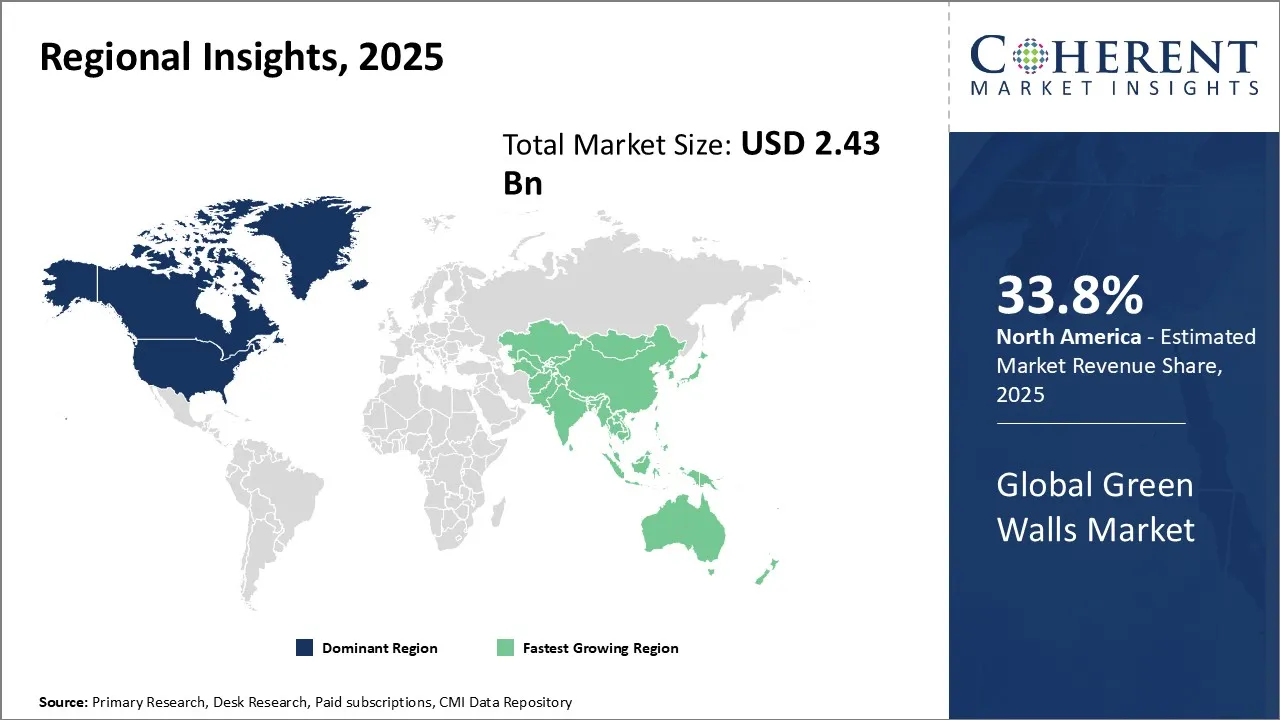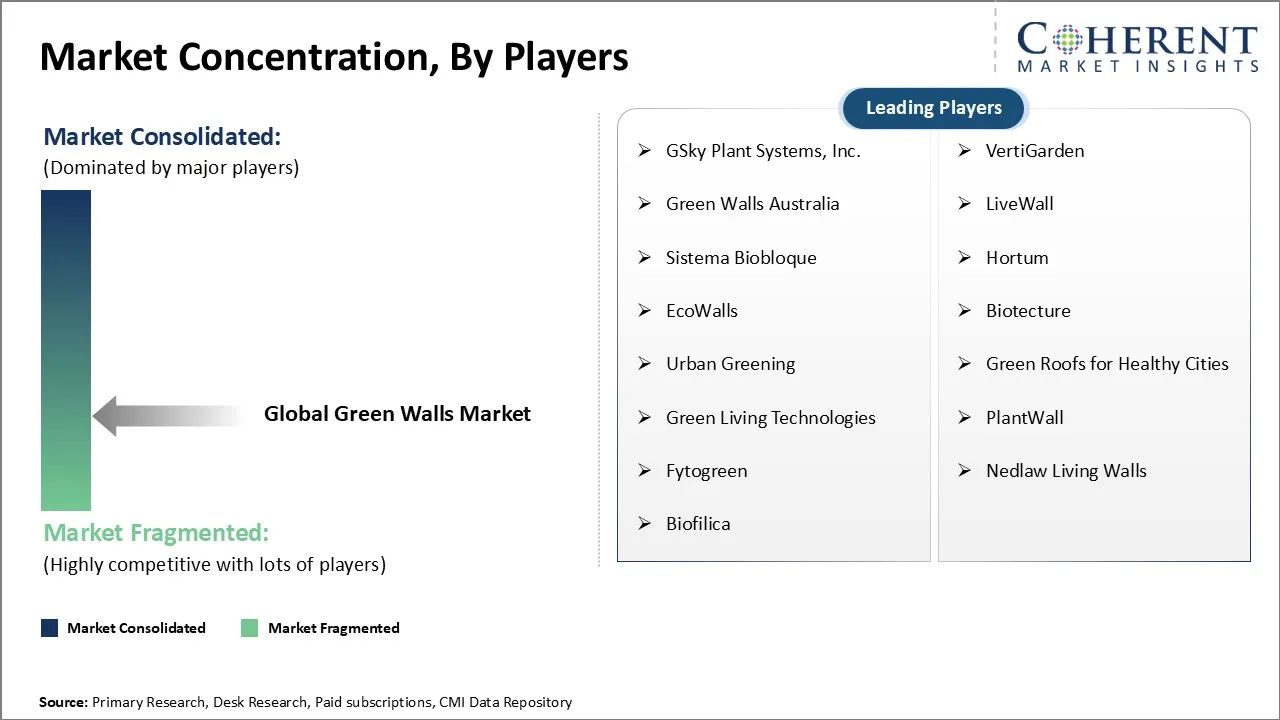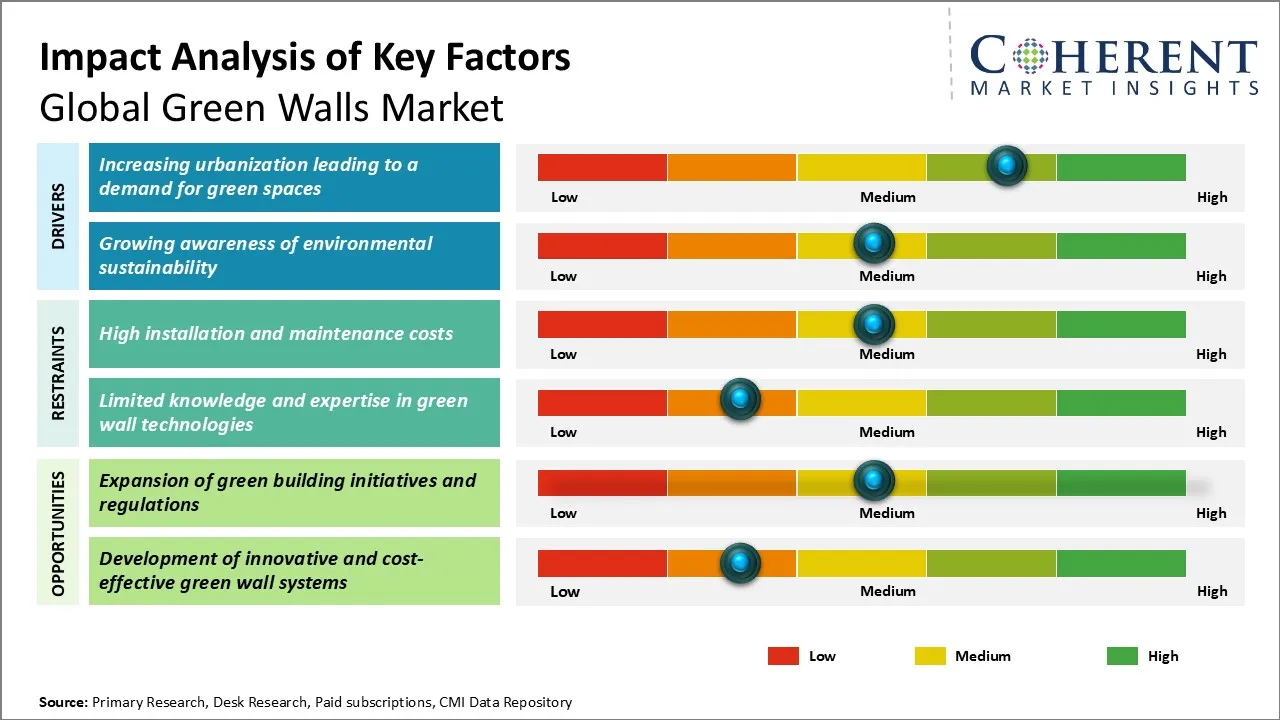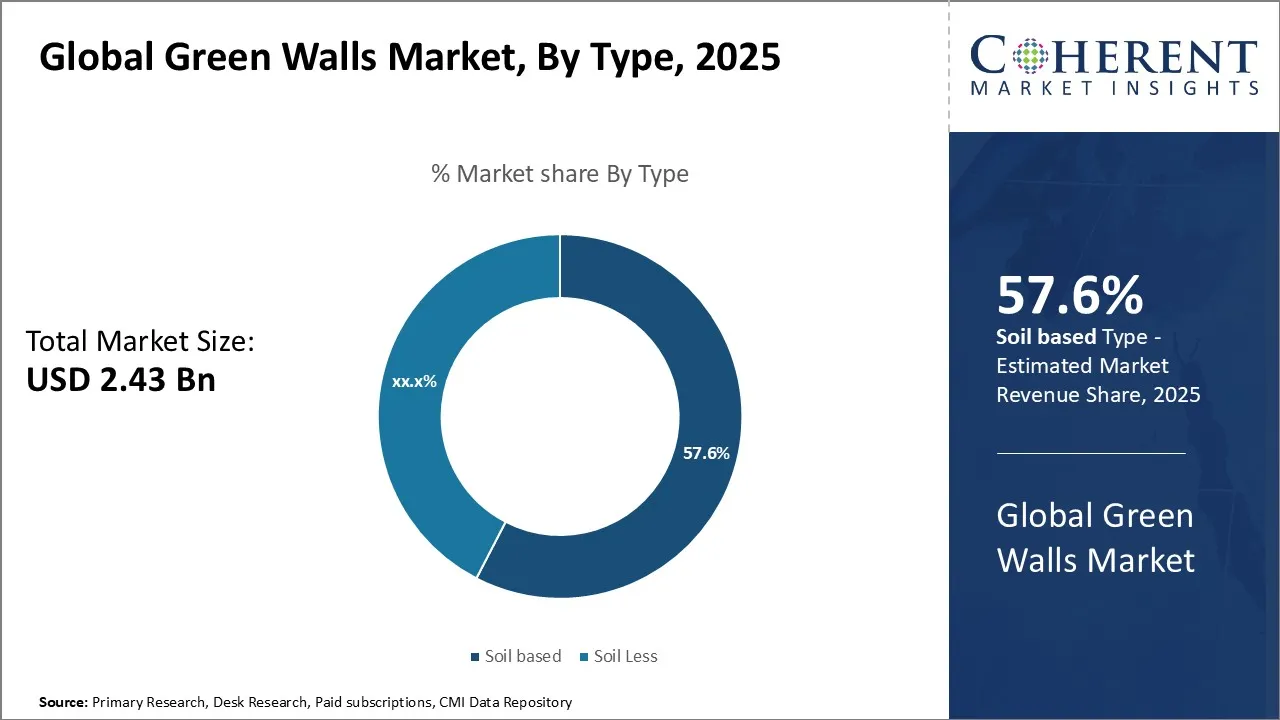Global Green Walls Market Size and Forecast – 2025-2032
The Global Green Walls Market is estimated to be valued at USD 2.43 Bn in 2025 and is expected to reach USD 3.55 Bn by 2032, exhibiting a compound annual growth rate (CAGR) of 5.6% from 2025 to 2032.
Key Takeaways of the Green Walls Market
- The soil based segment is expected to hold a 57. 6% share of the market in 2025.
- The interior green walls segment is projected to account for 34. 7% of the market in 2025.
- The outdoor green walls segment is expected to hold a 31. 7% share of the market in 2025.
- North America is set to lead the global green walls market in 2025 with a 33. 8% share. Asia Pacific, with an estimated 10.5% share in 2025, will be the fastest-growing region.
Market Overview
Current market trends indicate a significant shift towards integrating green walls into smart building designs, leveraging advanced irrigation and sensor technologies to optimize plant health and resource efficiency. Additionally, there is a growing emphasis on eco-friendly materials and native plant species, reflecting consumer preference for sustainable and low-maintenance green infrastructure that supports biodiversity and reduces environmental impact.
Current Events and Its Impact
|
Current Events |
Description and its impact |
|
Government Incentives and Urban Policy Shifts |
|
|
Technological Innovations in Materials and Design |
|
Uncover macros and micros vetted on 75+ parameters: Get instant access to report
Green Walls Market Insights, By Type – The soil-based segment leads the market, driven by the increasing demand for its sustainability benefits
Soil based segment is expected to contribute 57.6% share of the market in 2025, owing to its natural integration and sustainability benefits. The soil based segment holds a dominant position in the global green walls market due to several compelling factors rooted in environmental appeal and practical functionality. Unlike soil-less systems that generally rely on hydroponic or aeroponic techniques, soil based green walls offer a natural growth medium that facilitates long-term plant health and resilience. This organic substrate supports a wider variety of plant species, including those with deeper root systems, which enhances biodiversity and creates more visually appealing and ecologically balanced green walls.
Green Walls Market Insights, By Installation Type - The interior green walls segment leads the market, driven by the growing demand for indoor air purification and aesthetic enhancements
Interior green walls segment is expected to contribute 34.7% share of the market in 2025, driven by increased demand for indoor air purification and aesthetic improvements. The interior green walls segment commands the largest share within the installation type category largely due to the growing recognition of the health and wellbeing benefits associated with indoor greenery. Urban environments characterized by high-density living and office spaces often suffer from poor indoor air quality and limited access to nature. Interior green walls provide an innovative solution to these challenges by introducing living plant systems directly into indoor environments, which has garnered widespread adoption across commercial buildings, residential complexes, healthcare facilities, and educational institutions.
Green Walls Market Insights, By Application - The outdoor green walls segment dominates, driven by the rapid urbanization trend
Outdoor green walls segment is expected to contribute 31.7% share of the market in 2025, attributed to urbanization trends and the drive for sustainable building facades. Outdoor green walls represent the largest share within the application segment, primarily fueled by rapid urbanization and the global push toward environmentally sustainable construction practices. As metropolitan areas expand, space limitations and environmental challenges such as air pollution and heat island effects create an urgent need for green infrastructure that can mitigate these issues while optimizing limited urban space.
Regional Insights

To learn more about this report, Download Free Sample
North America Green Walls Market Analysis and Trends
The North America region is projected to lead the market with a 33.8% share in 2025, driven primarily by growing demand for sustainable urban development and increasing government initiatives supporting environmental conservation. North American cities are adopting green building certifications like LEED and WELL, which foster the integration of green infrastructure, including green walls, into urban landscapes. The market is characterized by a strong presence of experienced landscape architecture firms, technology developers, and construction companies specializing in sustainable solutions.
One of the leading players in the region, Green City Solutions, has significantly contributed to the adoption of green wall technology. The company has pioneered innovative green wall systems, notably in large urban projects in cities like New York and Toronto, helping these areas meet stringent environmental standards and improve urban air quality through their advanced hydroponic green wall solutions.
Asia Pacific Green Walls Market Analysis and Trends
The Asia Pacific region is expected to exhibit the fastest growth in the market contributing 10.5% share in 2025, due to rapid urbanization, rising environmental awareness, and government initiatives focused on enhancing urban liveability and combating pollution. Nations in this region are investing heavily in green infrastructure to mitigate urban heat island effects and improve air quality, creating strong demand for green walls.
The market ecosystem is evolving, with increasing collaboration between international companies and local enterprises, along with rising investment in research and development. Policy frameworks in countries like China, Japan, and Singapore emphasize green building certifications that support green wall adoption. Key players driving growth include BIOTecture, American Hydrotech, and Shanghai-based Skyfame Group, who have launched large-scale green wall projects and innovative modular systems catering to the fast-developing urban landscapes across Asia Pacific.
Green Walls Market Outlook for Key Countries
Germany Green Walls Market Trends
Germany green walls market benefits from a long-standing commitment to sustainability and environmental protection. Government incentives for green infrastructure projects, supported by strict environmental regulations, have encouraged the adoption of green walls in both new constructions and retrofit projects. Companies like Green City Solutions have implemented pioneering projects using moss-based green walls that contribute to urban air purification, making Germany a leader in innovative green wall technology within Europe.
U.S. Green Walls Market Trends
The U.S. green walls market is characterized by a mix of regulatory drivers and corporate sustainability goals. Several cities, such as New York and San Francisco, have integrated green walls into urban planning frameworks to reduce energy consumption and enhance aesthetic value. Industry leaders like American Hydrotech and Green Over Grey actively promote modular and customizable green wall systems, driving adoption in commercial buildings, educational institutions, and public spaces nationwide.
China Green Walls Market Trends
China’s rapidly expanding urban centers create a fertile environment for green walls market expansion. Government policies under the “Green Urbanization” initiative emphasize eco-friendly construction, encouraging developers to incorporate green walls to control pollution and improve urban microclimates. Local companies like Skyfame Group have been instrumental in developing large-scale green wall projects, leveraging cutting-edge vertical greening technologies customized for dense metropolitan settings such as Shanghai and Beijing.
U.K. Green Walls Market Trends
The U.K. green walls market is shaped by a growing emphasis on urban regeneration and sustainable architecture. Public and private sector collaboration facilitates the integration of green walls in commercial and residential developments. Companies, such as Sempergreen, deliver extensive green wall installations, focusing on enhancing urban aesthetics and air quality. The U.K.’s emphasis on low-carbon urban initiatives continues to fuel the demand for these living architecture solutions.
Macro and Micro Economic Factors Impacting Green Walls Market
The green walls market is influenced by a range of macro and microeconomic factors shaping its growth trajectory. On the macroeconomic front, rapid urbanization, increased government investments in infrastructure, and favorable regulatory policies promoting sustainability are major drivers. Governments worldwide are encouraging the adoption of green walls through incentives and regulations to combat climate change, improve urban air quality, and manage rising temperatures. The surge in construction activities, especially in residential and commercial sectors, coupled with rising disposable incomes and higher standards of living, further fuels demand for green walls as part of sustainable urban development.
At the microeconomic level, consumer awareness about environmental benefits, corporate sustainability initiatives, and the need for energy efficiency in buildings are significant factors. Green walls are increasingly seen as valuable for their ability to provide thermal insulation, reduce noise, and enhance property aesthetics, making them attractive to both commercial and residential developers. However, high installation and maintenance costs, the labor-intensive nature of upkeep, and the presence of counterfeit products pose challenges to market growth.
Market Players, Key Development, and Competitive Intelligence

To learn more about this report, Download Free Sample
Key Developments
- In June 2025, the Green Climate Fund (GCF) approved projects totaling over USD 300 million aimed at environmental sustainability. These initiatives, developed by the Food and Agriculture Organization (FAO), focus on forest protection in Papua New Guinea, promoting sustainable fisheries in Saint Lucia, and advancing Africa's Great Green Wall project. This approval, granted during the 42nd GCF Board meeting held in Papua New Guinea from June 30 to July 3 in 2025, marks the highest-value batch of project approvals by the GCF to date.
- In July 2024, President Bola Tinubu approved the appointment of Mr. Saleh Abubakar as the new Director-General of the National Agency for the Great Green Wall (NAGGW). According to a statement from presidential spokesman Mr. Ajuri Ngelale, Abubakar brings decades of experience in public administration across various sectors, positioning him to lead the agency in its environmental and sustainability efforts.
Top Strategies Followed by Global Green Walls Market Players
- Established market leaders invest heavily in research and development, continuously innovating to create high-performance products that meet evolving environmental standards and consumer expectations. These companies prioritize cutting-edge technologies such as advanced hydroponic systems, smart irrigation controls, and sustainable materials to enhance the functionality and appeal of their green wall solutions.
- For instance, Green City Solutions, a notable established player, specializes in integrating biofilters and hydroponic technologies in urban green walls. Its innovative approach not only enhances the aesthetic value of urban spaces but also improves air quality.
- Mid-level players in the green walls market adopt a more pragmatic strategy that balances cutting-edge features with cost-effectiveness, aiming to serve a broader segment of price-sensitive consumers. These companies concentrate on offering solutions that deliver reliable quality without the premium pricing of top-tier brands, making green walls accessible for small businesses, commercial spaces, and residential users seeking sustainable design options on a budget.
- For instance, LiveWall collaborates with local suppliers to incorporate easy-to-install, cost-effective green wall systems in residential and small commercial buildings. Its solutions focus on providing high-quality systems while optimizing for cost-efficiency, making green walls more accessible to a broader range of customers, such as small businesses or residential users.
- Small-scale players in the green walls marketplace differentiate themselves by carving out specialized niches through innovation and agility. Rather than competing head-to-head with larger corporations on volume or price, these companies often develop highly specialized or bespoke green wall solutions that emphasize unique features such as modularity, aesthetic customization, or integration with IoT-based environmental monitoring.
- For example, SingularGreen creates bespoke green walls that emphasize modularity, allowing users to customize plant arrangements according to their space and aesthetic preferences.
Market Report Scope
Green Walls Market Report Coverage
| Report Coverage | Details | ||
|---|---|---|---|
| Base Year: | 2024 | Market Size in 2025: | USD 2.43 Bn |
| Historical Data for: | 2020 To 2024 | Forecast Period: | 2025 To 2032 |
| Forecast Period 2025 to 2032 CAGR: | 5.6% | 2032 Value Projection: | USD 3.55 Bn |
| Geographies covered: |
|
||
| Segments covered: |
|
||
| Companies covered: |
GSky Plant Systems, Inc., VertiGarden, Green Walls Australia, LiveWall, Sistema Biobloque, Hortum, EcoWalls, Biotecture, Urban Greening, Green Roofs for Healthy Cities, Green Living Technologies, PlantWall, Fytogreen, Nedlaw Living Walls, and Biofilica |
||
| Growth Drivers: |
|
||
| Restraints & Challenges: |
|
||
Uncover macros and micros vetted on 75+ parameters: Get instant access to report
Green Walls Market Dynamics

To learn more about this report, Download Free Sample
Green Walls Market Driver - Increasing Urbanization Leading to a Demand for Green Spaces
The rapid pace of global urbanization has fundamentally transformed how cities approach environmental sustainability and quality of life improvements. According to the United Nations Department of Economic and Social Affairs, approximately 68% of the world's population is projected to live in urban areas by 2050, representing a significant increase from current levels. This demographic shift has created unprecedented challenges related to air quality, urban heat islands, and limited green space availability in densely populated areas. As traditional horizontal green spaces become increasingly scarce due to land constraints and high real estate costs, vertical green solutions have emerged as innovative alternatives.
Green Walls Market Opportunity - Expansion of Green Building Initiatives and Regulatory Support
The expansion of green building initiatives represents a transformative opportunity for the green walls market, driven by increasingly stringent environmental regulations and government mandates worldwide. Regulatory frameworks such as Leadership in Energy and Environmental Design (LEED), Building Research Establishment Environmental Assessment Method (BREEAM), and local green building materials codes, green construction are increasingly incorporating biophilic design elements, including living walls, as essential components for sustainable construction.
These initiatives are compelling developers, architects, and building owners to integrate nature-based solutions into their projects to meet certification requirements and regulatory compliance. For instance, cities like Singapore have implemented the Skyrise Greenery Incentive Scheme, which provides financial incentives for incorporating vertical gardens and green walls in urban developments, while the European Union's taxonomy for sustainable activities explicitly recognizes green infrastructure as a climate adaptation measure, encouraging member states to incorporate such solutions in urban planning.
Analyst Opinion (Expert Opinion)
- The global green walls market is poised for robust growth, driven by increasing urbanization and a heightened awareness of environmental sustainability. Companies like Verdon Green are pioneering innovative systems that integrate living walls into urban architecture, enhancing air quality and aesthetic appeal.
- Recent conferences, such as the International Green Roof Association (IGRA) Conference (2023) and the Green Cities Conference (2022), have emphasized the critical role that green walls play in urban design and climate resilience. These events showcased successful case studies where green walls have been implemented to improve energy efficiency and mitigate urban heat island effects. As cities increasingly prioritize sustainable infrastructure and green spaces, the global green walls market is well-positioned for significant expansion, driven by innovations that align with environmental goals and enhance urban living.
Market Segmentation
- Type Insights (Revenue, USD Bn, 2020 - 2032)
- Soil based
- Soil Less
- Installation Type Insights (Revenue, USD Bn, 2020 - 2032)
- Interior Green Walls
- Exterior Green Walls
- Freestanding Green Walls
- Integrated Facade Systems
- Application Insights (Revenue, USD Bn, 2020 - 2032)
- Outdoor
- Indoor
- Others
- Regional Insights (Revenue, USD Bn, 2020 - 2032)
- North America
- U.S.
- Canada
- Latin America
- Brazil
- Argentina
- Mexico
- Rest of Latin America
- Europe
- Germany
- U.K.
- Spain
- France
- Italy
- Russia
- Rest of Europe
- Asia Pacific
- China
- India
- Japan
- Australia
- South Korea
- ASEAN
- Rest of Asia Pacific
- Middle East
- GCC Countries
- Israel
- Rest of Middle East
- Africa
- South Africa
- North Africa
- Central Africa
- North America
- Key Players Insights
- GSky Plant Systems, Inc.
- VertiGarden
- Green Walls Australia
- LiveWall
- Sistema Biobloque
- Hortum
- EcoWalls
- Biotecture
- Urban Greening
- Green Roofs for Healthy Cities
- Green Living Technologies
- PlantWall
- Fytogreen
- Nedlaw Living Walls
- Biofilica
Sources
Primary Research Interviews
- Landscape Architect – Expert in green wall design and installation
- Urban Sustainability Officer – City planner focusing on green infrastructure
- Product Development Manager – Major Green Wall Solutions Provider
- Operations Manager – Leading Supplier of Hydroponic Systems
- Government Policy Expert – Specialist in urban environmental policies
Stakeholders
- Manufacturers
- End-use Sectors:
- Urban Development & Infrastructure (Green Wall Installations in Commercial Buildings, Parks, and Residential Projects)
- Landscaping & Architecture Firms specializing in sustainable building solutions
- Commercial Real Estate Developers focusing on eco-friendly design
- Public Sector (Government projects for sustainable urban development)
- Regulatory & Certification Bodies
- E-commerce Platforms and Retailers
- Technology Integration Players: Smart irrigation systems, AI for green wall management
Databases
- UN Comtrade Database
- India Import Export (EXIM) Database
- Environmental Protection Agency (EPA) Database
Magazines
- Sustainable Architecture Magazine – Green design trends in urban landscapes
- Urban Greening Journal – Innovations in green wall systems and vertical farming
- Green Building & Design – Focus on integrating green walls into sustainable architecture
- Landscape Architecture Magazine – Best practices and projects featuring green walls
Journals
- Journal of Environmental Management – Impact of green walls on urban air quality
- Urban Forestry & Urban Greening – Studies on the role of green walls in urban sustainability
- Journal of Building Engineering – Technological advancements in green wall installation
Newspapers
- The Financial Times – Market trends in the green building and infrastructure sectors
- The Guardian – Urban sustainability and green wall adoption
- The New York Times – Consumer preferences in green urban design and environmental architecture
- Asia Pacific Urban News – Growth of green walls and urban greening projects in Asia
- BBC News – Policy developments and government support for green infrastructure
Associations
- Green Building Council – Industry association for sustainable building practices, including green walls
- American Society of Landscape Architects (ASLA) – Advocacy for green infrastructure and sustainable urban design
- Urban Green Council – Promotes the development of green walls and other sustainable urban projects
- International Society of Arboriculture (ISA) – Collaboration for integrating trees and plants in urban spaces, including green walls
Public Domain Sources
- Environmental Protection Agency (EPA) – Guidelines for sustainable landscaping, including green walls
- European Commission – Urban greening regulations and policies for green infrastructure
- World Health Organization (WHO) – Benefits of green spaces, including green walls, for public health
Proprietary Elements
- CMI Data Analytics Tool, Proprietary CMI Existing Repository of information for last 8 years.
Share
Share
About Author
Ramprasad Bhute is a Senior Research Consultant with over 6 years of experience in market research and business consulting. He manages consulting and market research projects centered on go-to-market strategy, opportunity analysis, competitive landscape, and market size estimation and forecasting. He also advises clients on identifying and targeting absolute opportunities to penetrate untapped markets.
Missing comfort of reading report in your local language? Find your preferred language :
Transform your Strategy with Exclusive Trending Reports :
Frequently Asked Questions
EXISTING CLIENTELE
Joining thousands of companies around the world committed to making the Excellent Business Solutions.
View All Our Clients


